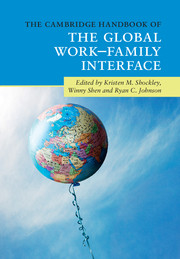Book contents
- The Cambridge Handbook of the Global Work–Family Interface
- The Cambridge Handbook of the Global Work–Family Interface
- Copyright page
- Contents
- Figures
- Tables
- Contributors
- Part I Overview
- Part II Assessing Cultural and Structural Differences
- Part III Methodological Considerations
- Part IV Review of Research in Regions across the Globe
- Part V Cultures within Cultures
- Part VI Organizational Perspectives
- 27 The Work–Family Interface and Careers in the Global Workplace: Insights from Cross-National Research
- 28 Managing Work–Life Effectiveness in a Multinational Firm: An Organizational Case Study
- 29 Workplace Flexibility: Strategies to Help Organizations Navigate Global Expansion
- 30 Organizational Culture in the Context of National Culture
- 31 Family-Supportive Supervision around the Globe
- Part VII Family Perspectives
- Part VIII Individual Perspectives
- Part IX Conclusion
- Index
- References
29 - Workplace Flexibility: Strategies to Help Organizations Navigate Global Expansion
from Part VI - Organizational Perspectives
Published online by Cambridge University Press: 16 April 2018
- The Cambridge Handbook of the Global Work–Family Interface
- The Cambridge Handbook of the Global Work–Family Interface
- Copyright page
- Contents
- Figures
- Tables
- Contributors
- Part I Overview
- Part II Assessing Cultural and Structural Differences
- Part III Methodological Considerations
- Part IV Review of Research in Regions across the Globe
- Part V Cultures within Cultures
- Part VI Organizational Perspectives
- 27 The Work–Family Interface and Careers in the Global Workplace: Insights from Cross-National Research
- 28 Managing Work–Life Effectiveness in a Multinational Firm: An Organizational Case Study
- 29 Workplace Flexibility: Strategies to Help Organizations Navigate Global Expansion
- 30 Organizational Culture in the Context of National Culture
- 31 Family-Supportive Supervision around the Globe
- Part VII Family Perspectives
- Part VIII Individual Perspectives
- Part IX Conclusion
- Index
- References
Summary
Information
- Type
- Chapter
- Information
- The Cambridge Handbook of the Global Work–Family Interface , pp. 533 - 554Publisher: Cambridge University PressPrint publication year: 2018
References
Accessibility standard: Unknown
Why this information is here
This section outlines the accessibility features of this content - including support for screen readers, full keyboard navigation and high-contrast display options. This may not be relevant for you.Accessibility Information
- 1
- Cited by
